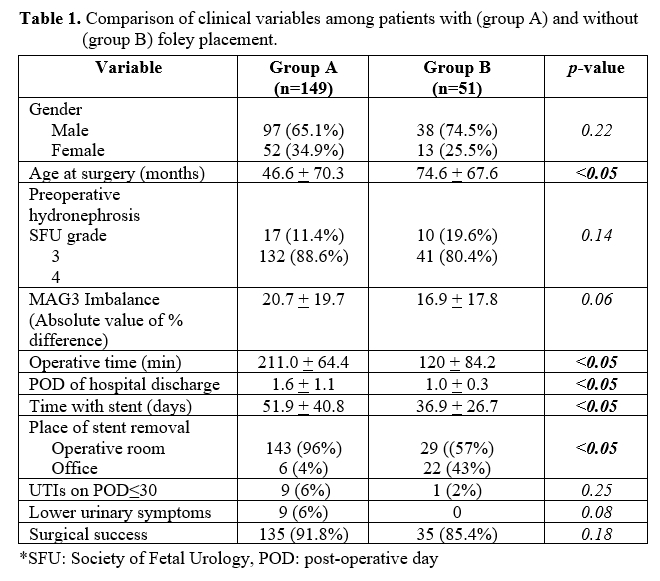Back
Poster, Podium & Video Sessions
Podium
PD48: Pediatic Urology: Genitalia, Upper & Lower Urinary Tract
PD48-07: Pediatric Pyeloplasty and Perioperative Urethral Catheter : What are the benefits?
Sunday, May 15, 2022
2:00 PM – 2:10 PM
Location: Room 244
Maria Camila Suarez*, Sirpi Nackeeran, Daniel E. Nassau, Alireza Alam, Rafael Gosalbez, Miguel Castellan, Miami, FL

Maria Camila C. Suarez, MD
Research fellow
University of Miami, Miller School of Medicine
Podium Presenter(s)
Introduction: It is a common practice to place an indwelling ureteral stent and urethral catheter after pediatric pyeloplasty. The foley is routinely removed on post-operative day (POD) 1; however, even with a limited indwelling time, it can increase the risk of urinary tract infection (UTI). Despite the short duration use of urethral catheters, it is unknown if they can be safely omitted during pyeloplasty. We recently discontinued perioperative foley use during pyeloplasty and aimed to compare the safety profile and outcomes of our early experience to a cohort of patients who had foley placement during pyeloplasty.
Methods: Our prospectively maintained database of patients who underwent pyeloplasty without use of a foley catheter from 2019-2021 was queried. Retrospective chart review was done from 2012-2020 of patients who underwent pyeloplasty with foley placement. Patients were excluded if they were >21 years of age. Indwelling ureteral stents with or without a string were placed in all patients either retrograde via cystoscopy immediately prior to the procedure or antegrade during the ureteropelvic junction reconstruction. Statistically significant differences between patients with and without foley were assessed using chi-squared tests, t-tests, Fischer’s exact and Wilcoxon Rank-Sum; where alpha=0.05.
Results: A total of 149 patients with (group A) and 51 patients without (group B) foley placement were included in the study. Comparison of clinical variables among groups is shown in table 1. The mean operative time, POD of hospital discharge, and time of stent indwelling were statistically significant higher in group A than group B. Stent was removed in the office in 4% of group A and 43% of group B, in all other cases it was removed in the operating room cystoscopically and under general anesthesia. The incidence of UTI during the first 30 POD was higher in group A than group B (4.6% vs 2%), however it was not statistically significant (p=.25). Lower urinary symptoms in the first 30 POD also presented more frequently in group A (6%) than group B (0%) with p=0.08. Only 4% of group A required a redo-procedure; till the date none of the patients of group B had required a redo-pyeloplasty.
Conclusions: Pediatric pyeloplasty without foley placement showed a favorable safety profile with durable post-operative outcomes across a wide range of clinical variables. “Foley-less” pyeloplasty had benefits beyond a low incidence of UTIs, including shorter operative time and days from discharge, and increasing the frequency of ureteral stents left on a string, negating the need for cystoscopic stent removal under general anesthesia.
Source of Funding: None

Methods: Our prospectively maintained database of patients who underwent pyeloplasty without use of a foley catheter from 2019-2021 was queried. Retrospective chart review was done from 2012-2020 of patients who underwent pyeloplasty with foley placement. Patients were excluded if they were >21 years of age. Indwelling ureteral stents with or without a string were placed in all patients either retrograde via cystoscopy immediately prior to the procedure or antegrade during the ureteropelvic junction reconstruction. Statistically significant differences between patients with and without foley were assessed using chi-squared tests, t-tests, Fischer’s exact and Wilcoxon Rank-Sum; where alpha=0.05.
Results: A total of 149 patients with (group A) and 51 patients without (group B) foley placement were included in the study. Comparison of clinical variables among groups is shown in table 1. The mean operative time, POD of hospital discharge, and time of stent indwelling were statistically significant higher in group A than group B. Stent was removed in the office in 4% of group A and 43% of group B, in all other cases it was removed in the operating room cystoscopically and under general anesthesia. The incidence of UTI during the first 30 POD was higher in group A than group B (4.6% vs 2%), however it was not statistically significant (p=.25). Lower urinary symptoms in the first 30 POD also presented more frequently in group A (6%) than group B (0%) with p=0.08. Only 4% of group A required a redo-procedure; till the date none of the patients of group B had required a redo-pyeloplasty.
Conclusions: Pediatric pyeloplasty without foley placement showed a favorable safety profile with durable post-operative outcomes across a wide range of clinical variables. “Foley-less” pyeloplasty had benefits beyond a low incidence of UTIs, including shorter operative time and days from discharge, and increasing the frequency of ureteral stents left on a string, negating the need for cystoscopic stent removal under general anesthesia.
Source of Funding: None


.jpg)
.jpg)